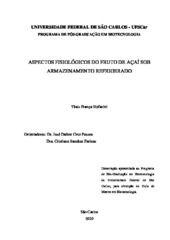| dc.contributor.author | Stefanini, Thais França | |
| dc.date.accessioned | 2016-08-17T18:39:39Z | |
| dc.date.available | 2011-10-13 | |
| dc.date.available | 2016-08-17T18:39:39Z | |
| dc.date.issued | 2010-08-10 | |
| dc.identifier.citation | STEFANINI, Thais França. Physiological aspects of açaí berry in cold storage. 2010. 78 f. Dissertação (Mestrado em Multidisciplinar) - Universidade Federal de São Carlos, São Carlos, 2010. | por |
| dc.identifier.uri | https://repositorio.ufscar.br/handle/ufscar/6982 | |
| dc.description.abstract | The açaí berry market has been increasing due to its high calorie characteristic and antioxidant activity, that contributes to diseases prevention. The market growth makes it the center of attention, upcoming the necessity to study its storage, transportation and processing chain. So this study has the objective to analyze the physiology and storage conditions of the açaí berry through measures of respiration, based on temperature and water content, freezing point detection, water potential due to water content function, cohesion of the mesocarp, color of the parenchymal reserve, pH level, acidity and contents of anthocyanins. The respiration based on the temperature of the açaí berry can be fitted by Arrhenius curve with activation energy of 79.6 kJ.mol-1. Q10 values for the açaí berry were between 2 and 3.The metabolism of the açaí berry showed and exponential result related to the reduction in water content. The average freezing temperature was around -3.4 º C, and maximum of -1.8 ° C. The hidroconservation storage reduces oxidation of anthocyanins, due to its low temperature. However, fruits stored in hidroconservation showed possible characteristics of freezing injury and anaerobic conditions, indicated by the presence of aqueous solution produced by the fruit inside the package, reducing the mesocarp cohesive force, changing the parenchyma s reserves colour and acidity variations. The refrigerator storage leads to a fast decrease in total anthocyanins. The gas permeability of the used packaging process reduces the anaerobic process, and its higher storage temperature decreases the symptoms of freezing injury, but increases fruit water loss. | eng |
| dc.format | application/pdf | por |
| dc.language | por | por |
| dc.publisher | Universidade Federal de São Carlos | por |
| dc.rights | Acesso Aberto | por |
| dc.subject | Biotecnologia | por |
| dc.subject | Euterpe oleracea | por |
| dc.subject | Respiração | por |
| dc.subject | Congelamento | por |
| dc.subject | Potencial de água | por |
| dc.subject | Açaí - qualidade | por |
| dc.subject | Euterpe oleracea | eng |
| dc.subject | Respiration | eng |
| dc.subject | Freezing | eng |
| dc.subject | Water potential | eng |
| dc.subject | Quality | eng |
| dc.subject | Hidroconservation | eng |
| dc.subject | Mesocarp cohesion | eng |
| dc.title | Aspectos fisiológicos do fruto de açaí sob armazenamento refrigerado | por |
| dc.title.alternative | Physiological aspects of açaí berry in cold storage | eng |
| dc.type | Dissertação | por |
| dc.contributor.advisor1 | Pessoa, José Dalton Cruz | |
| dc.contributor.advisor1Lattes | http://lattes.cnpq.br/4212703554284544 | por |
| dc.description.resumo | A polpa de açaí vem se destacando no mercado por apresentar alto valor calórico e atividade antioxidante, benéfica na prevenção de doenças. O crescimento de seu mercado o torna o centro das atenções, apresentando cada dia mais necessidades de estudos sobre armazenamento, transporte e beneficiamento do fruto de açaí. Assim este trabalho teve como objetivo estudar a fisiologia e o armazenamento do fruto de açaí através de medidas de respiração em função da temperatura e do teor de água, determinação do ponto de congelamento, potencial de água em função do teor de água, coesão do mesocarpo, cor do parênquima de reserva, pH, acidez titulável e antocianinas totais. A respiração em função da temperatura do fruto de açaí pode ser ajustada por uma curva de Arrhenius, com energia de ativação de 79,6 kJ.mol-1. Os valores de Q10 para o fruto de açaí foram entre 2 e 3. O metabolismo do fruto de açaí respondeu exponencialmente à redução no teor de água. Foi encontrada temperatura de congelamento média de -3,4ºC e máxima de -1,8ºC. O armazenamento no hidroconservador reduz a oxidação das antocianinas, devido à sua baixa temperatura. Porém os frutos armazenados no hidroconservador apresentaram possíveis sintomas de injúria por frio e anaerobiose, indicados pela presença de soluto aquoso proveniente dos frutos dentro das embalagens, redução da força de coesão do mesocarpo, alteração na cor do parênquima de reserva e variações na acidez titulável. O armazenamento em geladeira levou a uma rápida redução no teor de antocianinas totais. A permeabilidade da embalagem a gases atmosféricos utilizada possivelmente reduziu o processo de anaerobiose e a maior temperatura de armazenamento diminuiu os sintomas de injúria pelo frio, porém aumentou a perda de água dos frutos. | por |
| dc.publisher.country | BR | por |
| dc.publisher.initials | UFSCar | por |
| dc.publisher.program | Programa de Pós-Graduação em Biotecnologia - PPGBiotec | por |
| dc.subject.cnpq | CIENCIAS BIOLOGICAS::FISIOLOGIA | por |
| dc.contributor.authorlattes | http://lattes.cnpq.br/6293022488155409 | por |
